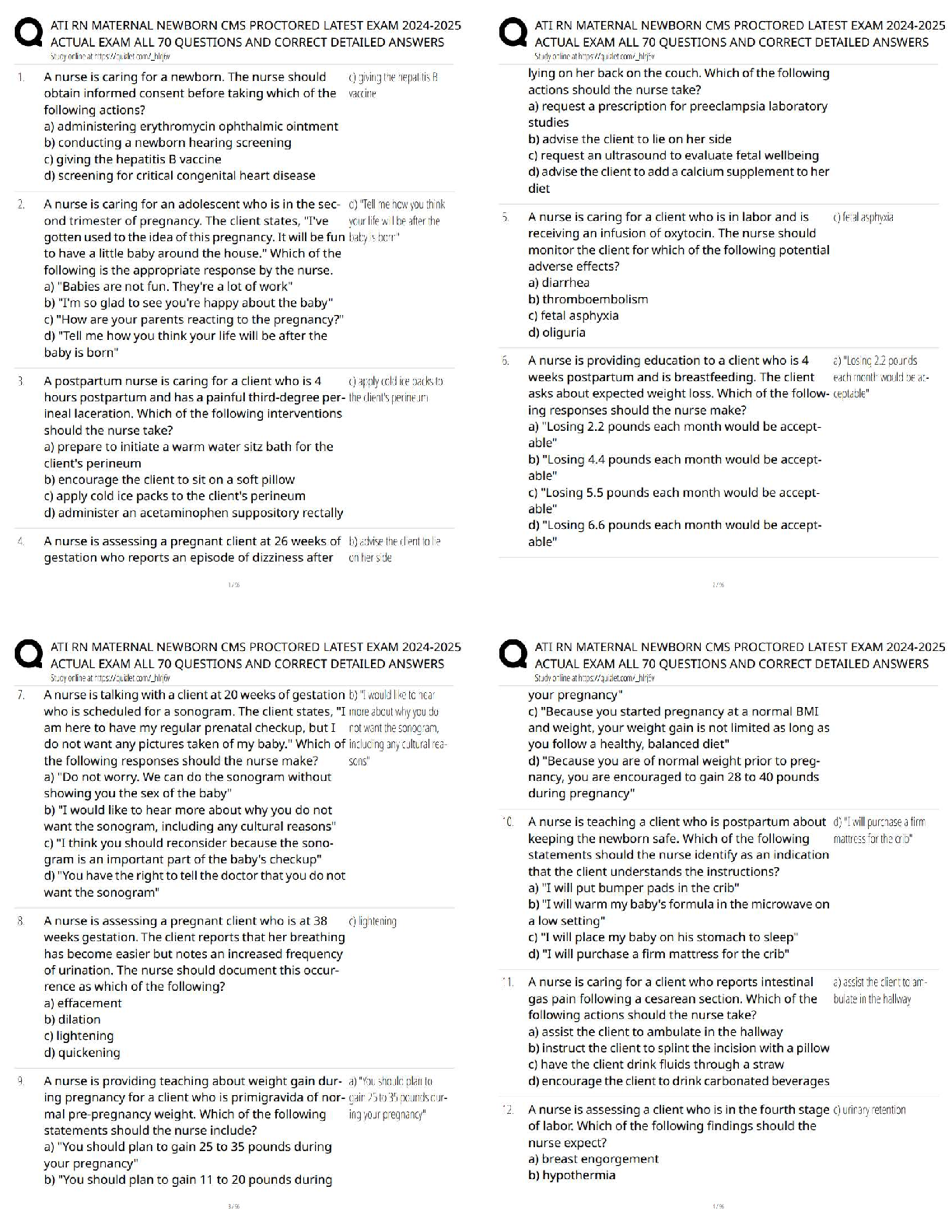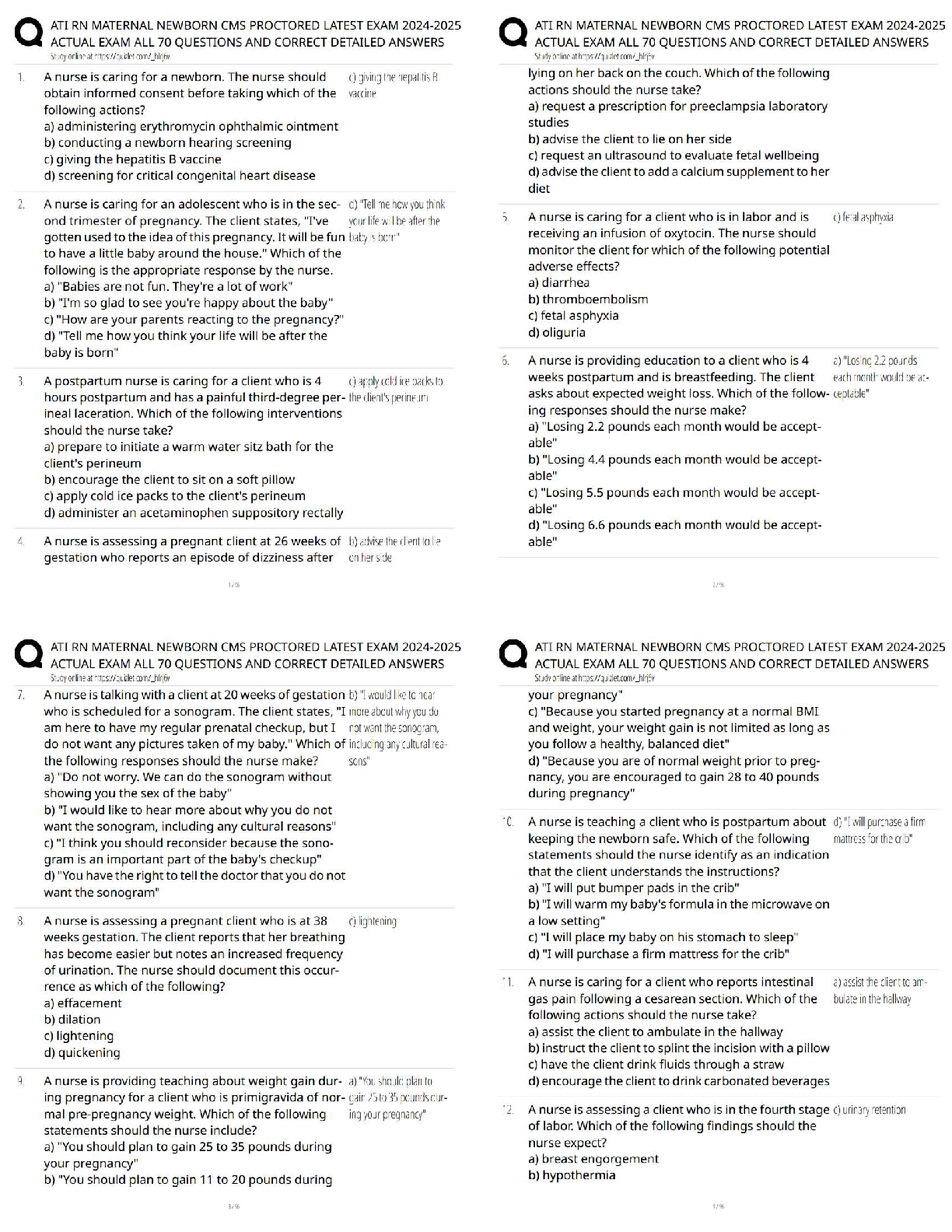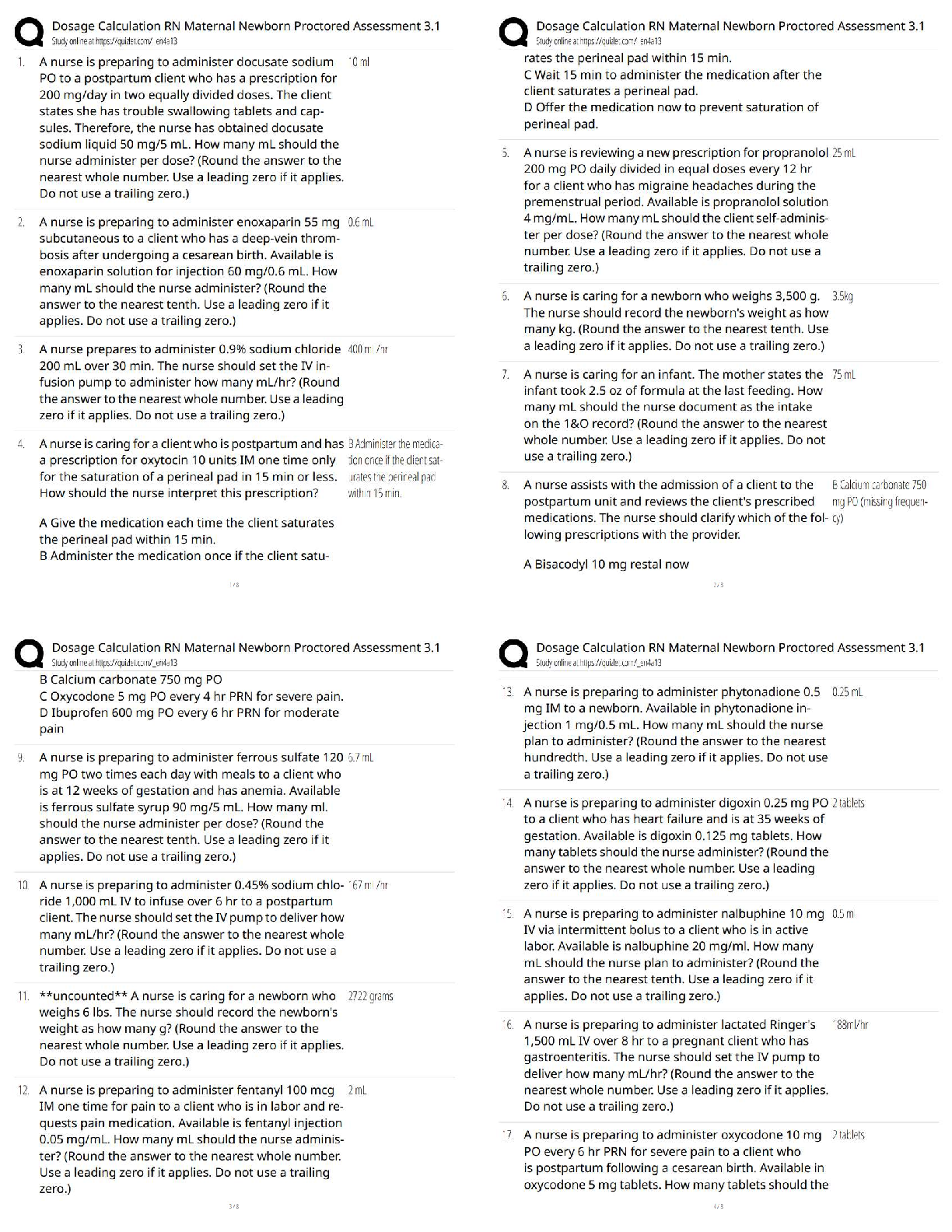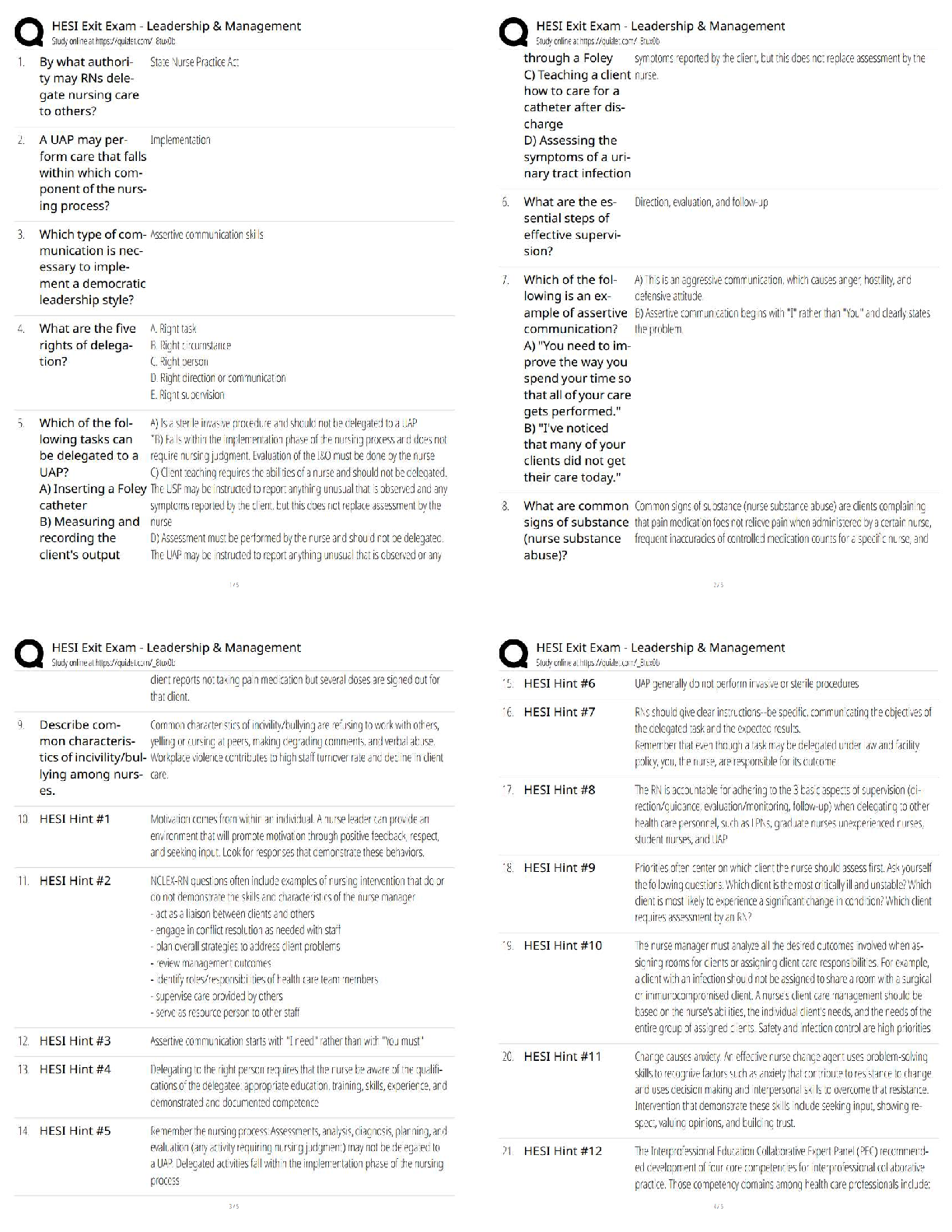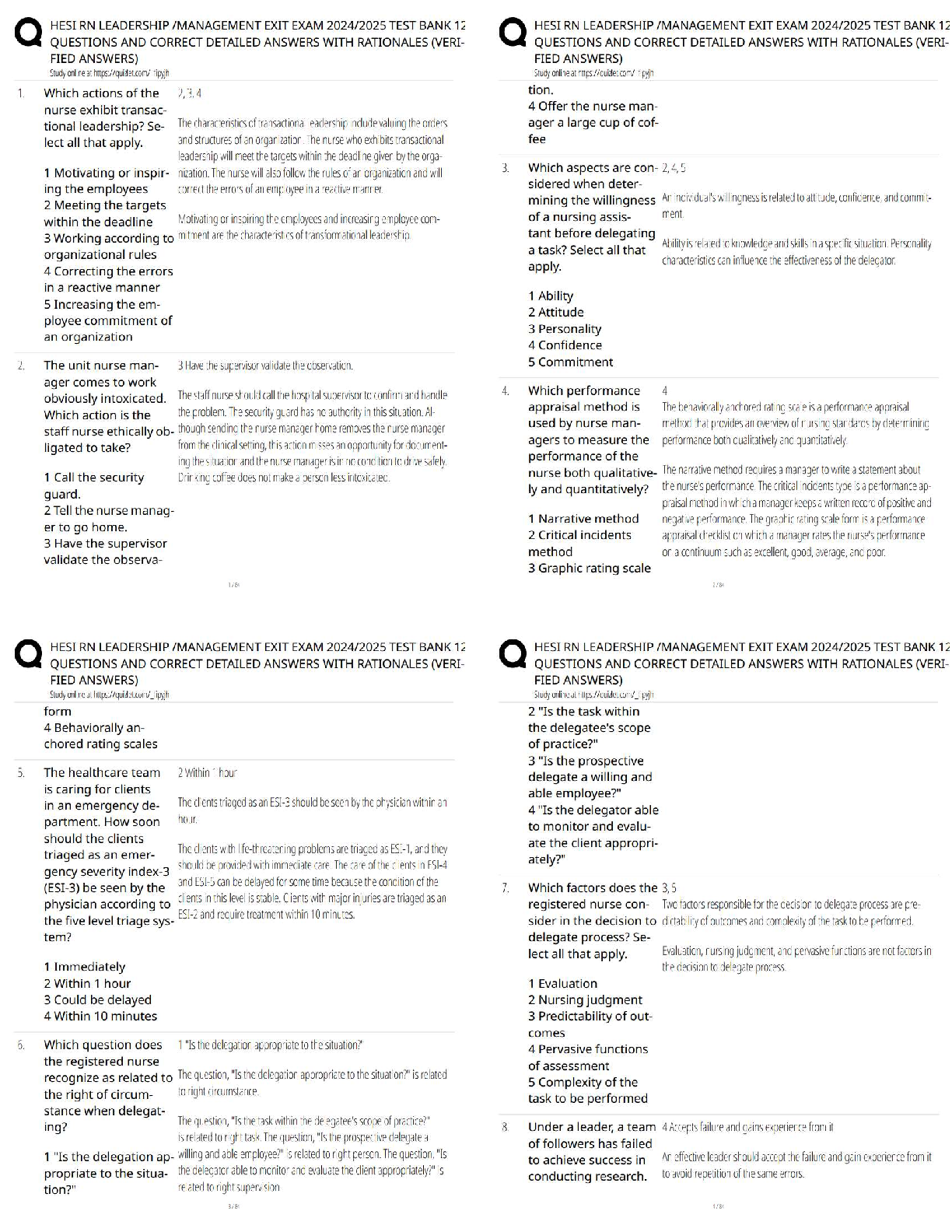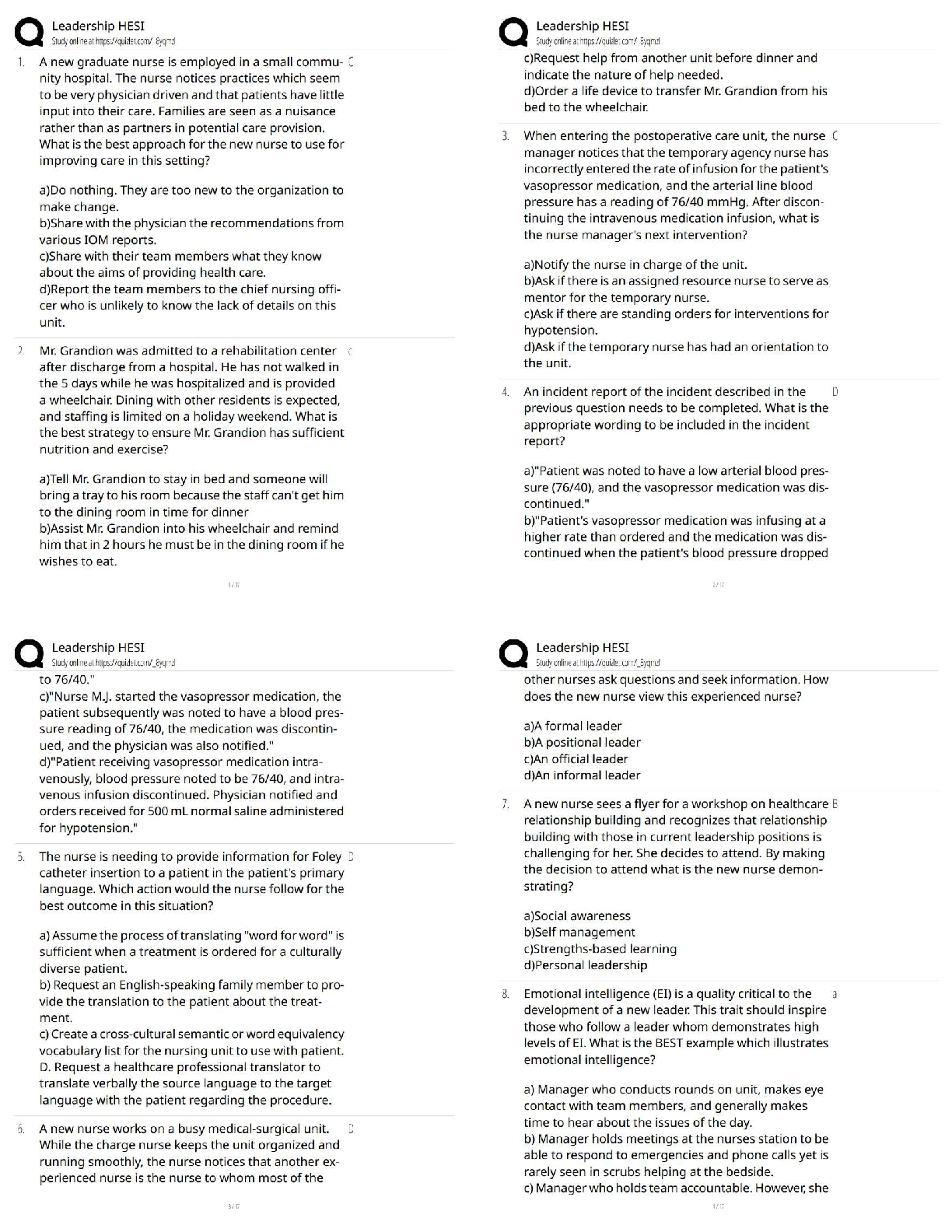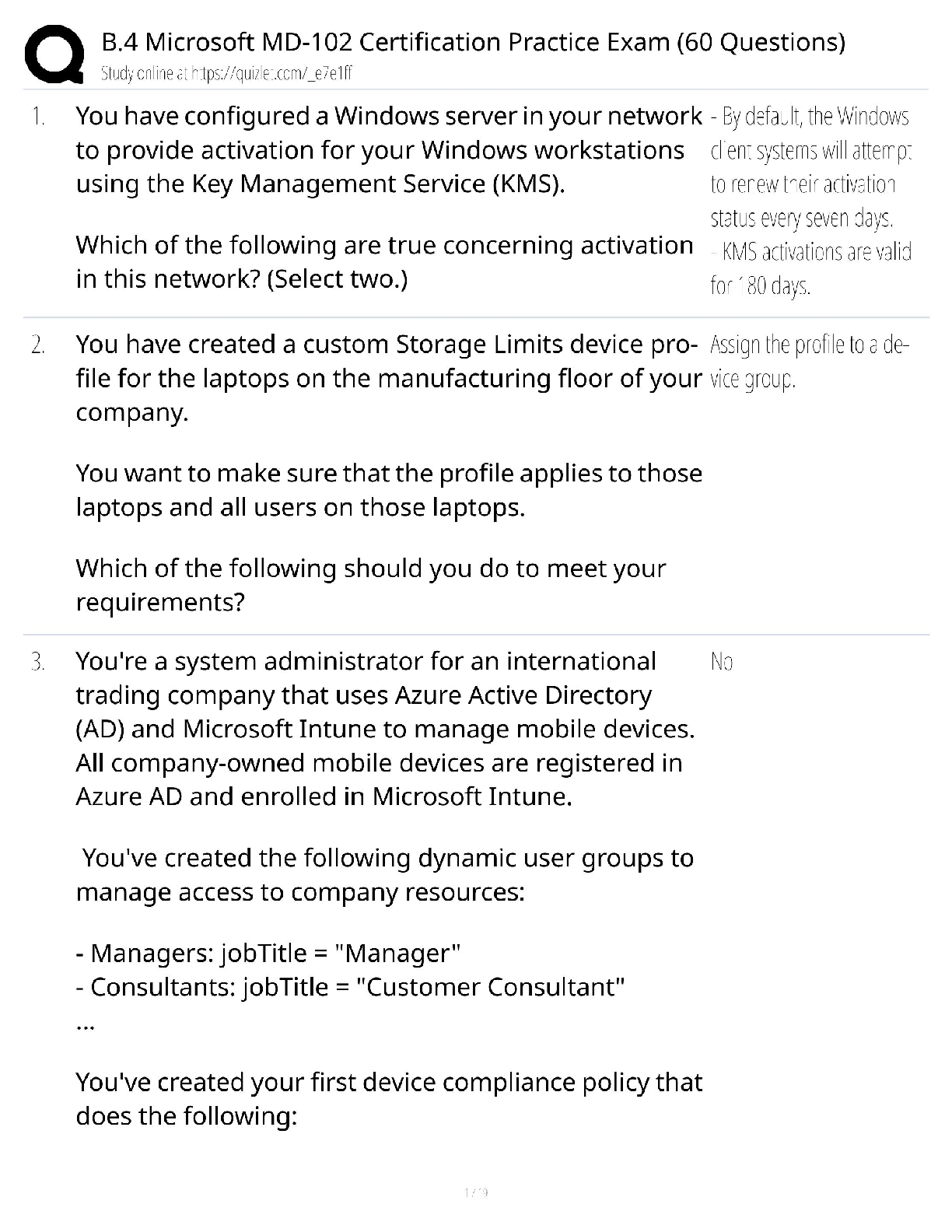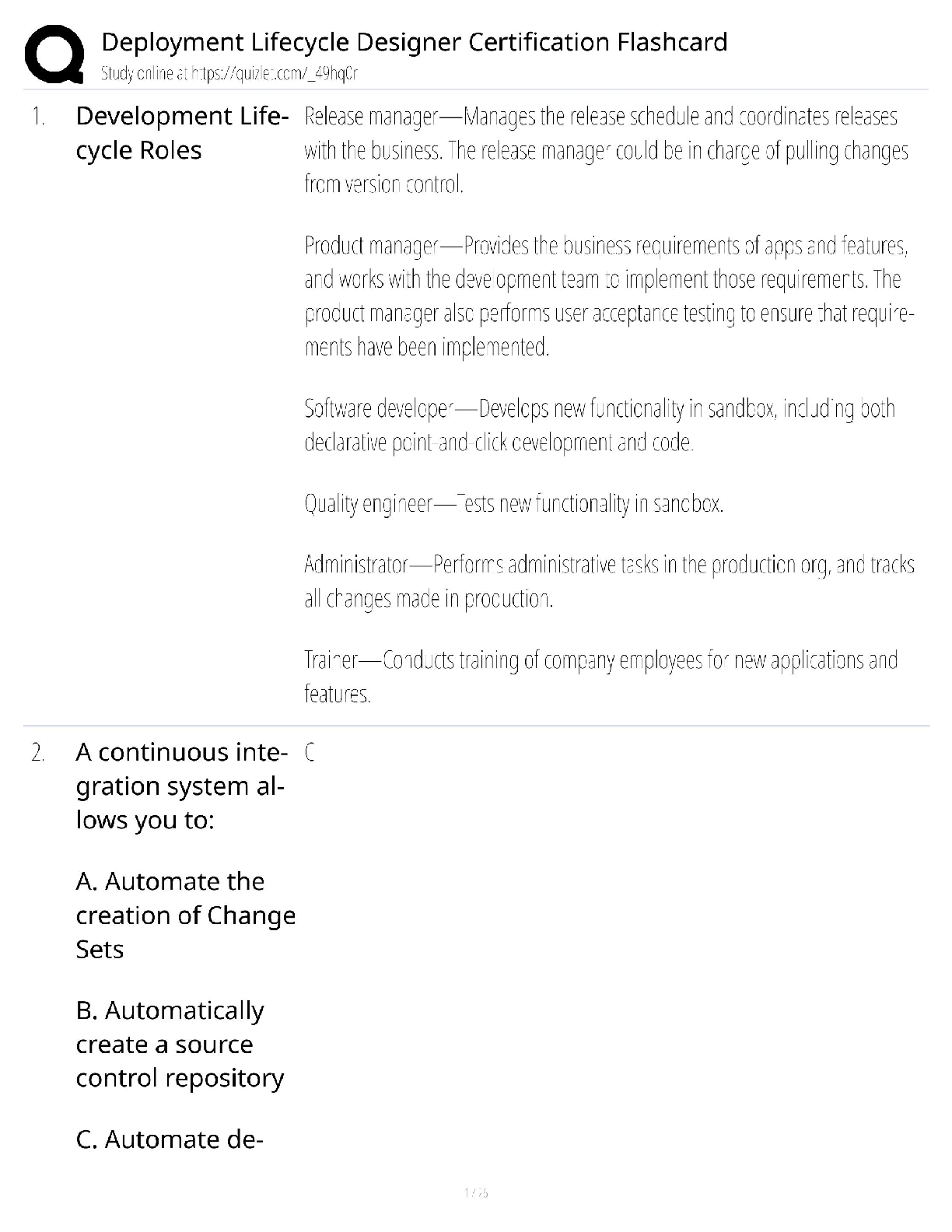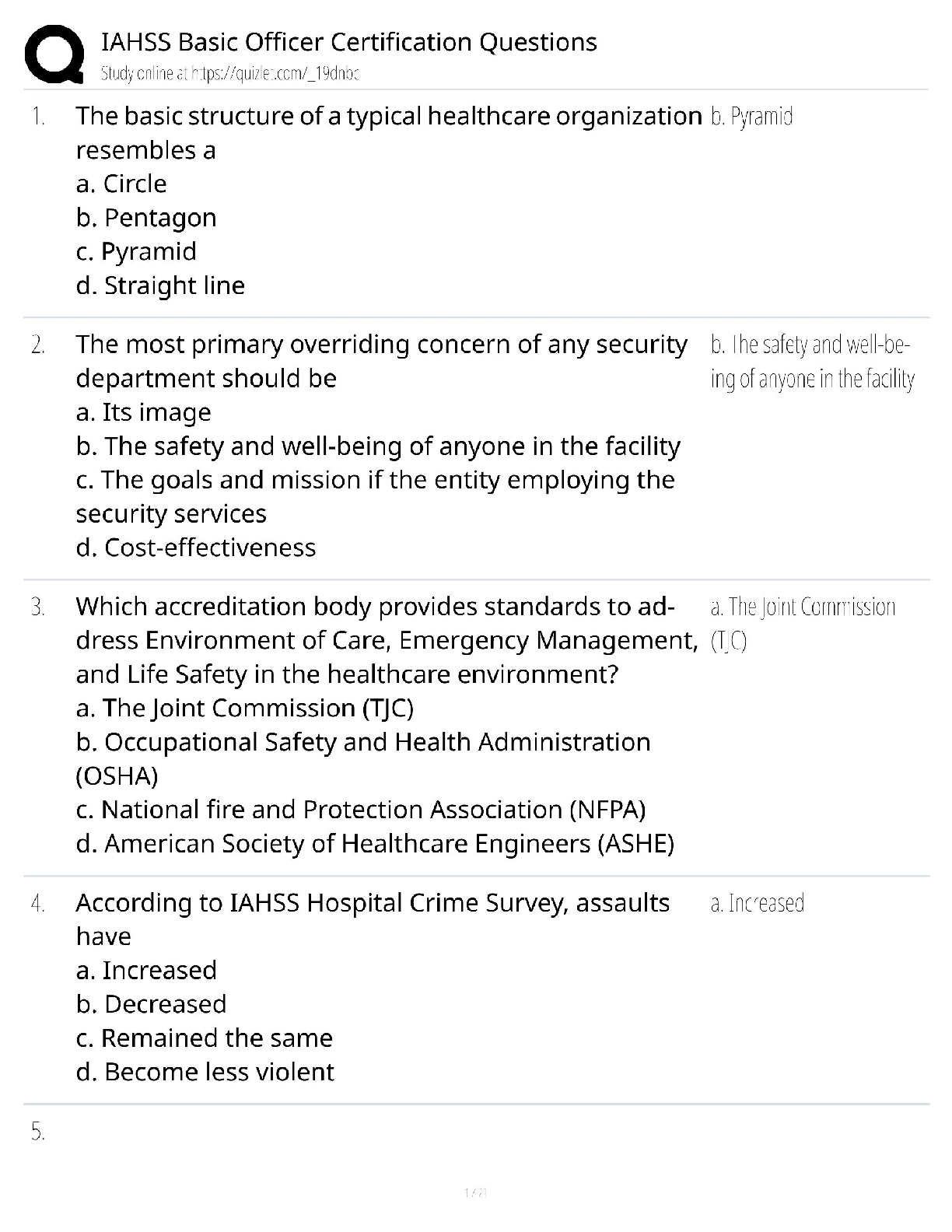Health Care > QUESTIONS & ANSWERS > CPH Exam Practice Questions with accurate answers, 2022/2023 update. Graded A (All)
CPH Exam Practice Questions with accurate answers, 2022/2023 update. Graded A
Document Content and Description Below
CPH Exam Practice Questions with accurate answers, 2022/2023 update. Graded A The lengths of stay for six patients were 0, 0, 1, 2, 2, and 16 days. Which is (are) the best measure(s) to summari ... ze these data? A) Mean B) Median C) Median and SD D) Mean and SD E) Median and Range - ✔✔E) Median and Range An epidemiologist attempts to predict the weight of an elderly person from demispan. She randomly chooses 70 elderly subjects in a particular geographic area and records their weight and demispan measurements in the form of (x i , y i ) for i = 1...70. Given that the value of the Pearson correlation coefficient is zero, what can be deduced? 1) There is no relation between weight and demispan B) There is an almost perfect relationship between weight and demispan C) There could be some nonlinear relationship between weight and demispan D) There is a strong negative relationship between weight and demispan E) All pairs of values of weight and demispan are practically identical - ✔✔C) There could be some nonlinear relationship between weight and demispan Which of the following statistical tests is NOT considered a nonparametric test? A) Kruskal-Wallis Test B) Wilcoxon's rank-sum test C) Tukey's test D) Mann-Whitney test - ✔✔C) Tukey's test A researcher is designing a new questionnaire to examine patient stress levels on a scale of 0 to 5. What type of outcome variable is being collected? A) Ratio B) Nominal C) Interval D) Ordinal E) Binary - ✔✔B) Ordinal In simple linear regression, what is a method of determining the slope and intercept of the best-fitting line? A) Least squares B) R-square C) Minimum error D) Least Error E) Regression - ✔✔A) Least Squares The sensitivity of a particular screening test for a disease is 95%, and the specificity is 90%. Which of the following statements is most correct? (A) Of 100 people sampled from a population with the disease, the test will correctly detect 95 individuals as positive for the disease (B) Of 100 people sampled from a population with the disease, the test will correctly detect 90 individuals (C) If a person tests positive, the probability of having the disease is 0.95 (D) If a person has the disease, there is a 5% chance that the test will be negative (E) If a person does not have the disease, there is a 5% chance that the test will be positive - ✔✔A) Of 100 people samples from a population with the disease, the test will correctly detect 95 individuals as positive for the disease. Sensitivity is the proportion of truly diseased people in the screened population who are identified as diseased by the screening test. It is a measure of the probability of correctly diagnosing a case or the probability that any given case will be identified by the test (e.g., true positives). Specificity is the proportion of truly non-diseased people who are so identified by the screening test. It is a measure of the probability of correctly identifying a nondiseased person with the screening test (e.g., true negatives). The Central Limit Theorem states that: A) The sample mean is unbiased B) The sample mean is approximately normal C) The parent population of the sample distribution is normally distributed D) The sample SD is approximately normal E) Both statements A) and C) can be deduced from the Central Limit Theorem - ✔✔B) The sample mean is approximately normal The Central Limit Theorem states that if the sample size is large enough, the distribution of the sample means can be approximated by a normal distribution, even if the original population is not normally distributed. In other words, the distribution of the sample means approaches a normal distribution as the sample size increases Assume that a researcher has measured weight in a sample of 100 overweight adults before and after a diet and exercise program conducted at the local health department's weekly Eat Health - Be Fit community program. To determine whether the mean weight decreased six weeks after the exercise program compared to the initial baseline measures, the researcher should: A) Compute the correlation coefficient, r, and determine the association between being overweight and the community program B) Conduct a t-test for independent samples C) Conduct a t-test for dependent samples D) Conduct a chi-square test for association E) Not estimate the decrease because there was no control group for the program - ✔✔C) Conduct a t-test for dependent samples A t-test is a hypothesis test to compare population means and proportions. In this case, the sample is dependent because the tests are performed on the same individuals in the sample. Which of the following estimates of an odds ratio most strongly suggests a computational error? 1) 7.8 2) 1.2 3) -0.9 4) 20.9 - ✔✔3) -0.9 An odds ratio of -0.9 most strongly indicates a computational error because an odds ratio is calculated using probabilities, which cannot be negative. An odds ratio is the probability that an event will occur divided by the probability that it will not occur. Since probabilities cannot be negative, a negative odds ratio would indicate computational error. Which measure of mortality would you calculate to determine the proportion of all deaths that is caused by heart disease? A) Case Fatality Ratio B) Randomized Clinical Trial C) Crude Mortality Rate D) Proportional Mortality Ratio - ✔✔D) Proportional Mortality Ratio the proportion of deaths in a particular population over a specified period of time attributable to a specific disease An incremental approach to program planning in public health is: 1) Uses multiple sources and methods to collect similar information 2) Provides an intensive, detailed description and analysis of a single project 3) Produces a plan where the specification of every step depends up on the results of previous steps 4) Results in plans that may be immediately necessary but may overlap or leave gaps - ✔✔4) Results in plans that may be immediately necessary but may overlap or leave gaps The incremental approach to program (a little bit more is added each time) planning may address an immediate need (ex: Closing bathhouses in the early days of HIV/AIDS epidemic) it may also leave gaps (ex: Did not identify the virus). The incremental approach to program planning will address only part of the problem, may be the result of disjointed efforts and leave many factors unaccounted for. In a state with a state-directed pubic health organization, the State Commissioner of Health has notified health districts to close health department dental programs in response to a state legislature vote to defund and discontinue health department dental services. The district health department has identified dental services as a leading community health need. To help assure continued access to services, the best first step is to: 1) Develop a list of possible venues and proposals to secure financial support, and present them to the Commissioner's office 2) develop agreements with local providers or organizations for the provision of dental services 3) continue the dental program in-house at the local health department, since it was already financially sustainable and heavily utilized 4) ensure implementation of contracts and other agreements with community partners to provide community dental services - ✔✔1) Develop a list of possible venues and proposals to secure financial support, and present them to the Commissioner's office Since the upper chain of state health command has ordered dental service closure, consultation with the Commissioner's office will be needed to assure compliance with legislative directives and fidelity to state health department policy. The likelihood of support from the state-level is greater if it is well-defined and sustainable options are presented. A researcher has implemented an intervention. The program activities include STD counseling for the members of a community-based organization. One outcome measure would be best addressed by which of the following questions? 1.) Did STD counseling result in changes in knowledge among the target population? 2.) When did the program activities take place? 3.) What are the barriers to implementation of program activities? 4.) What is the number of people who received counseling? - ✔✔1.) Did STD counseling result in changes in knowledge among the target population? Outcome evaluation measures the program effects on the target population. Which of the following is the most accurate exposure assessment in workers? 1.) Determination of the chemical in the air 2.) Biomonitoring of chemicals or metabolites in blood or urine 3.) Determination of the chemical on the skin 4.) Estimation of the exposure by taking an occupational history - ✔✔2.) Biomonitoring of chemicals or metabolites in blood or urine Biomonitoring gives the best estimate for individual exposure. This approach involves collecting bodily fluids or other biological samples and analyzing them for the presence of a contaminant, the metabolite of the contaminant, or a biological response. Biomonitoring proves that absorption of a contaminant has occurred and accounts for absorption through all routes of exposure. Because individuals naturally vary in their ability to metabolize a compound, biomonitoring can indicate which individuals are most susceptible to deleterious health effects from an exposure. Other approaches to estimating an individual's exposure, such as measuring a contaminant's presence in the air, determining a contaminant's presence on the skin, or completing a job-exposure matrix will not yield information about uptake, metabolism, and individual susceptibilities. If a food contaminated with a virus, such as hepatitis A, is left out for 4 hours in a kitchen at a temperature of 85 degrees Fahrenheit, the virus count in the food: 1) increases exponentially 2) increases slowly 3) depends on the acidity of food 4) does not change - ✔✔4) does not change Viruses can only grow in living cells and will not multiply under these circumstances. Viruses can only replicate themselves by infecting a host cell and therefore cannot reproduce on their own. Which of the following statements is not associated with the current paradigm of quality management? 1) Sanctioning individuals for mistakes is the most appropriate method for ensuring effective quality of care. 2) The appropriate locus for ensuring quality is at the system level 3) Process improvement is essential to ensuring quality of care 4) Employee satisfaction and patient satisfaction are closely linked - ✔✔1) Sanctioning (punishing) individuals for mistakes is the most appropriate method for ensuring effective quality of care This is the only correct response because the current quality management paradigm considers the primary source of errors, waste, and other indicators of poor quality to be poor system design and ineffective processes rather than individual incompetence or carelessness. Deming and others regard the sanctioning of individuals for poor quality to be misplaced and likely to aggravate the problem. Focus on errors in the system - not the individual. Which term is used to characterize the movement addressing the social condition of unequal distribution of environmental hazards experienced by minority populations or groups with low income? 1) Environmental equity 2) Environmental justice 3) Environmental pollution 4) Environmental democracy - ✔✔Churches and other nonprofit interest groups that launched the environmental fairness movement in the 1980s articulated their mission using the term "Environmental Justice." The overarching premise is fairness in the distribution of the burden of pollution across all population groups regardless of race, ethnicity or socio-economic status. The term "Environmental equity" is not the best answer because while it may be a component of environmental justice, it is more limited. Environmental justice encompasses equity, as well as equality and fairness. The term "Environmental pollution" is only vaguely expressive of the message, but does not capture concern with how exposure to environmental pollution is distributed across a population. The term "Environmental democracy" is completely wrong because it is not about majority rule. If it were a matter of majority rule, than minority health could be in serious jeopardy. Environmental equity is an outcome of Environmental justice. https://www.mobilizegreen.org/blog/2018/9/30/environmental-equity-vs-environmental-justice-whats-the-difference If two events are mutually exclusive, to determine the probability that one or the other happened: 1) Double their probabilities 2) Add their conditional probabilities 3) Add their individual probabilities 4) Multiply their individual probabilities - ✔✔3) Add their individual probabilities mutually exclusive (disjoint): describes events which cannot occur at the same time, such as a screening test indicating that someone is both positive and negative for a condition The special addition rule of probability holds that for two mutually exclusive events, the probability that one or the other of the events has occurred is equal to the sum of of the probabilities of each event. Since we are concerned with the probability of either event occurring, conditional probability, which relates to the probability of one event occurring given that the other event has already occurred, is not relevant. Similarly, multiplying the probabilities of the two events would express the probability of both independent events occurring. Doubling their probabilities would also not be relevant. Which of the following best describes the elasticity of demand for health care in the United States? A) Perfectly elastic B) Perfectly Inelastic C) Relatively Elastic D) Relatively Inelastic - ✔✔D) Relatively Inelastic: relatively large changes in price cause relatively small changes in quantity In other words, quantity is not very responsive to price. More specifically, the percentage change in quantity is less than the percentage change in price. A health behavior survey conducted in a large urban area includes a question about whether a person is a smoker. The company conducting the survey decides to increase the size of its random sample of survey participants from 1,5000 people to approx. 20,000 people. This change will most likely have which of the following effects? A) Decreasing the variability of the estimate B) Increasing the standard error of the estimate C) No effect on survey stats because the population size is the same D) Increase the CI width for the parameter - ✔✔A) Decreasing the variability of the estimate As sample size increases, the range decreases, which means variability decreases. On the basis of the present evidence, the greatest reduction in injuries and death related to motor vehicles in the US is most likely to be a result of which of the following? A) Stricter motor vehicle inspection laws B) Modifications to vehicles and highway systems C) Increase in law enforcement and highway patrol officers D) Stiffer penalties for drunk drivers and repeat speeders - ✔✔B) Modifications to vehicles and highway systems Which of the following organizations accredits local public health departments? A) CDC B) APHA C) State Licensing Boards D) Public Health Accreditation Board - ✔✔D) Public Health Accreditation Board Which of the following is the largest source of radiation dose to the general public nation wide? A) Medical use of x-rays B) Nuclear Power Plants C) Radon Gas D) Nuclear weapons testing fallout - ✔✔C) Radon Gas Which of the following best describes the tendency for an insured person to overuse health services because he has insurance? A) Adverse Selection B) Crowding Out C) Risk Aversion D) Moral Hazard - ✔✔D) Moral Hazard The introduction of sewage into a stream is most likely to cause a measurable change in which of the following ways? A) Decrease in decomposing organic concentration B) Increase in biochemical oxygen demand C) Increase in dissolved oxygen concentration D) Stabilization in dissolved oxygen concentration - ✔✔B) Increase in biochemical oxygen demand Biochemical Oxygen Demand: amount of dissolved oxygen needed by aerobic biological organisms to break down organic material present in a given water sample at certain temperature over a specific time A researcher is calculating the infant mortality rate of several states. Which of the following methods is appropriate to use during this analysis to adjust for racial differences in infant mortality rates among the states? A) Direct standardization B) Linear Regression C) Logistic Regression D) Life Table Analysis - ✔✔A) Direct Standardization The direct method of standardization requires that the age-specific rates for all populations being studied are available and that a standard population is defined. Logistic Regression: used to describe data and to explain the relationship between one dependent binary variable and one or more nominal, ordinal, interval or ratio-level independent variables. Linear Regression: used when your response variable is continuous Life Table Analysis: tool to analyze occurrences of an event through time, presents the proportion surviving, the cumulative hazard function, and the hazard rates of a large group of subjects followed over time In addition to ozone and particulates, which of the following is most likely to aggravate asthma? A) Sulfur dioxide B) Carbon Monoxide C) Asbestos D) Nitrogen - ✔✔A) Sulfur Dioxide Sulfur dioxide causes a range of harmful effects on the lungs, as the EPA's most recent review of the science concluded... (https://www.lung.org/our-initiatives/healthy-air/outdoor/air-pollution/sulfur-dioxide.html) Requiring health care providers to report individual cases of disease as they are diagnosed to state or local health departments is an example of which of the following types of surveillance: A) Passive B) Active C) Syndromic D) Sentinel - ✔✔A) Passive Surveillance Public health actions frequently involve a balancing of individual rights vs. the good of the community. Where that balance is struck is based on: 1) Explicit direction found in the Nation's Constitution 2) Societal Values 3) Science 4) Deontological principles - ✔✔2) Societal Values The Constitution does not provide explicit direction when it comes to balancing individual rights and promoting the common good. Public health policy and regulation, although based on scientific evidence and general moral considerations is not likely to be adopted where there is not general consensus and support by the public it serves to protect. The definition: "Public Health is what we, as a society, do collectively to assure the conditions in which people can be healthy" suggest the need for cooperative actions built on overlapping values and trust. Which of these has been defined as a core function of public health? 1) Maintaining the census to define populations 2) Consulting stakeholders to decide what best serves public interest 3) Conducting research to solve all population health problems 4) Acting in an ethical manner - ✔✔2) Consulting stakeholders to decide what best serves public interest 10 Essential Services of Public Health: https://www.cdc.gov/publichealthgateway/publichealthservices/pdf/Ten_Essential_Services_and_SDOH.pdf Which of the following components of a strategic planning process in a public health agency has logical priority over the others? (Key words: Strategic Planning Process) 1) Preparing an action plan for eradicating giardiasis in the municipal water system 2) Developing the operating budget and staffing plan for the agency 3) Reviewing (and revising) the vision and mission statements for the agency 4) Setting strategic goals for a three-year cycle - ✔✔3) Review (and revising) the vision and mission statements for the agency The initial activity in the prevailing strategic planning paradigm is the review and (as needed) revision of the organization's mission and vision statements and its core values. This provides a philosophical foundation for subsequent steps in the strategic planning process. The best multi-platform software product to support public health field investigators who want a program on their portable device capable of generating survey questionnaires and analyzing survey data is: 1) Excel 2) Epi-Info 3) SAS 4) R Statistics - ✔✔2) Epi-Info Epi-Info is a public domain product widely used by public health agency staff. Unlike the other statistical analysis software listed, it is unique in supporting creation of questionnaires and transferring data for those questionnaires directly into the tables for analysis. (https://www.cdc.gov/epiinfo/index.html) Which of the following is consistent with broadly accepted theory of adult learning? 1) Adults are busy, so unlikely to want participation in planning and evaluation of instruction 2) They tend to be most interested in learning things of immediate relevance and practical value 3) Activities promoting memorization are preferable to trial-and-error experiential learning 4) Adult learning preference is content-oriented rather than problem-centered - ✔✔2) They tend to be most interested in learning things of immediate relevance and practical value Malcolm Knowles put forward a set of assumptions and principles for adult learning (andragogy) as a maturation continuum in pedagogy-andragogy ranging from teacher-directed to student-directed learning. This is an important framework to consider when designing educational programs for mature individuals. To determine whether to expand a component of a current intervention, which type of evaluation is needed? 1) Formative evaluation 2) Process evaluation 3) Outcome evaluation 4) Impact evaluation - ✔✔1) Formative evaluation Ensures that a program or program activity is feasible, appropriate, and acceptable before it is fully implemented. It is usually conducted when a new program or activity is being developed or when an existing one is being adapted or modified. (http://sphweb.bumc.bu.edu/otlt/mph-modules/ProgramEvaluation/ProgramEvaluation2.html) The leadership in a public health organization has decided to conduct a training needs assessment of its staff, identify training needs, and to invest in training and other resources to ensure that the organization is able to carry out its essential functions and its mission, now and into the future. This is a/an example of: 1) Capacity building 2) Efficiency Study 3) Continuous Quality Improvement 4) Feasibility Study - ✔✔1) Capacity building Capacity building in an organization are categorized by efforts of the organization to enhance ability to competently achieve its (operational, programmatic, financial) goals now and into the future (https://www.cdc.gov/publichealthgateway/funding/rfaot13.html) Which of the following is the most commonly occurring mosquito-borne disease in the United States? 1) West Nile 2) Yellow Fever 3) Dengue Fever 4) Malaria - ✔✔1) West Nile Virus (Neuro-Invasive) (https://www.cdc.gov/westnile/index.html) Which of the following survey items best assesses an individual's SES in terms of increasing validity and response rate? 1) Income in the past month 2) Highest level of education attained 3) Eligibility for public assistance 4) Perception of economic insecurity - ✔✔4) Perception of economic insecurity Of all the options, perception of economic insecurity (e.g., concern about food insecurity) best assesses an individual's current economic status while reducing non-response due to concern about stigma. Respondents are least likely to respond to income and public assistance questions, while educational attainment does not accurately reflect one's economic situation. From Peter Drucker, often identified as the founding father of the science of management, it is clear that efficiency is most meaningful in terms of the: 1) perspective within the organization 2) perspective outside the organization 3) financial cost and efforts of the organization 4) units of time - ✔✔In "The Effective Executive" (Harper & Row Publishers, 1967), Drucker comments that "...the organization is an abstraction... Specifically, there are no results within the organization. All the results are on the outside. The only business results, for instance, are produced by a customer who converts the costs and efforts of the business into revenues and profits through his willingness to exchange his purchasing power for the products or services of the business... Similarly, a hospital has results only in respect to the patient. But the patient is not a member of the hospital organization. For the patient, the hospital is 'real' only while he stays there. His greatest desire is to go back to the 'nonhospital' world as fast as possible." In this era of personalized medicine, a growing number of biomarkers are becoming readily available to individuals. Which of the following presents the greatest ethical concerns? 1) Cancer biomarkers (e.g. specific gene mutations or elevated expression levels) 2) Direct to consumer family heritage genomic analysis services 3) Blood Typing 4) Newborn Cystic Fibrosis Screening - ✔✔2) Direct to consumer family heritage genomic analysis services The other types of markers are used within the context of medical diagnosis or prognosis testing, so covered by patient privacy conventions. Unlike licensed medical service providers and clinical laboratories, direct-to-consumer commercial genomic services do not operate under the same legal constraints on ownership and privacy, which has raised concerns National Physical Activity Guidelines for Americans suggests adults need to participate in at least 150 minutes per week in moderate intensity physical activity for substantial health benefits. A study was designed to test whether there is the difference in mean time (in minutes) spent in moderate intensity physical activity in adults with no, mild, moderate and severe depression. Time spent in moderate intensity physical activity is a continuous measure which can be assessed using an accelerometer. Which among the following is the most appropriate statistical technique to test the difference in time spent in moderate intensity physical activity between adults with no, mild, moderate and severe depression? 1) Spearman correlation 2) ANOVA 3) t-test 4) chi-square test - ✔✔2) ANOVA ANOVA compared two or more independent groups (in this case it will be 4 types of adults i.e. those with no, mild, moderate or severe depression) on the measure of the dependent variable (time spent in moderate intensity physical activity) at a selected probability level. (https://www.spss-tutorials.com/anova-what-is-it/) A supervisor asks three staff members to work together on developing and implementing a community health needs assessment. The supervisor has requested the final needs assessment to be completed in three weeks and after two and a half weeks, only two of the staff members have completed their sections. What would be the best way for the supervisor to give constructive feedback to the staff members who has not completed their assignment? 1) Point out all the issues they have had with this staff member's performance to-date. 2) Prepare by developing a "feedback sandwich" approach with two corrective statements surrounding a reinforcing statement. 3) Give feedback to the staff member as the supervisor catches them on their way into the office 4) Hold the entire time accountable in a group meeting. - ✔✔2) Prepare by developing a "feedback sandwich" approach with two corrective statements surrounding a reinforcing statement. The ability to give constructive feedback is a critical skill for all professionals. As a result, specific approaches need to be used to ensure that the person receiving the feedback understands and makes adjustments to their practice. A "feedback sandwich" is one method, however, it consists of two reinforcing statements surrounding a corrective statement. Generally, feedback should focus on the specific situation to be addressed and not every single performance issue. The best time is addressing each situation right after each occurrence, but when that is not possible, planning for a specific time and place to address the issue is best. A 911 emergency operation center is flooded with calls at certain times of the day. What is the distribution that is most often used to assess this data? 1) Normal 2) Binomial 3) Hypergeometric 4) Poisson - ✔✔4) Poisson The Poisson distribution is used to model data that represent the number of occurrences of a specific event in a fixed period of time. Total coliform and E. coli counts are performed in routine monitoring of drinking water reservoirs because: 1) These bacteria commonly cause GI infection in humans 2) They are a more easily grown indicator ofLegionella spp. contamination 3) Outdated laws require heterotrophic plate count monitoring of water 4) Their numbers give general indication of a water supply's sanitary condition - ✔✔4) Their numbers give general indication of a water supply's sanitary condition Coliform bacteria are a group of bacteria present in the environment, and in the feces of humans as well as all warm-blooded animals. Few cause disease in humans. Some strains of E. coli are common only in wild/domestic animals, others in humans. They are all heterotrophic (meaning they require nutrients in growth media) and are monitored by plate counts as an indicator of sanitary quality food or water. When their heterotrophic plate count numbers are high, this is an indication of contamination from sources that also might introduce disease-causing organisms (pathogens, including bacteria, viruses or protozoa). High counts trigger public health responses like boil water advisories, product recalls, additional investigation of water treatment or food production practices. From a political perspective, which type of analysis provides the weakened identification of social and economic impact? 1) Cost benefit analysis 2) Cost effectiveness analysis 3) Cost minimization analysis 4) Cost utility analysis - ✔✔3) Cost minimization analysis Selecting a policy, program, or initiative that has the least direct cost w/o doing any estimation of possible benefit(s) might satisfy those who only believe in small government. Cost-benefit: considers whether fiscal value of benefits could outweigh costs Cost-effectiveness: identifies which of several options produces the most benefit for the least expenditure Cost-utility: adds weighing of financial benefit in terms of perceived desirability of such benefits to recipients Which of the following best characterizes the contingency theory of leadership? [Show More]
Last updated: 3 years ago
Preview 1 out of 49 pages
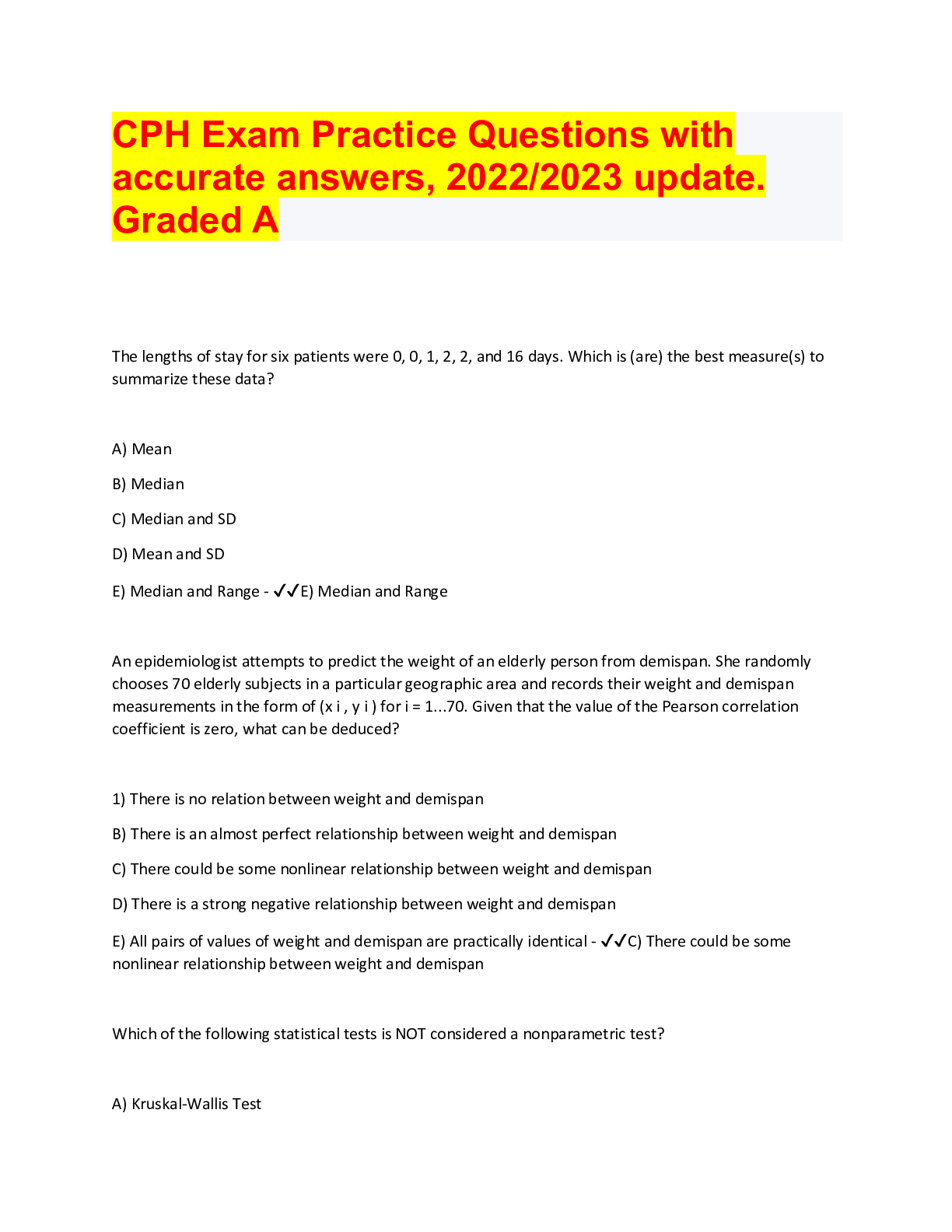
Buy this document to get the full access instantly
Instant Download Access after purchase
Buy NowInstant download
We Accept:

Also available in bundle (1)
Click Below to Access Bundle(s)
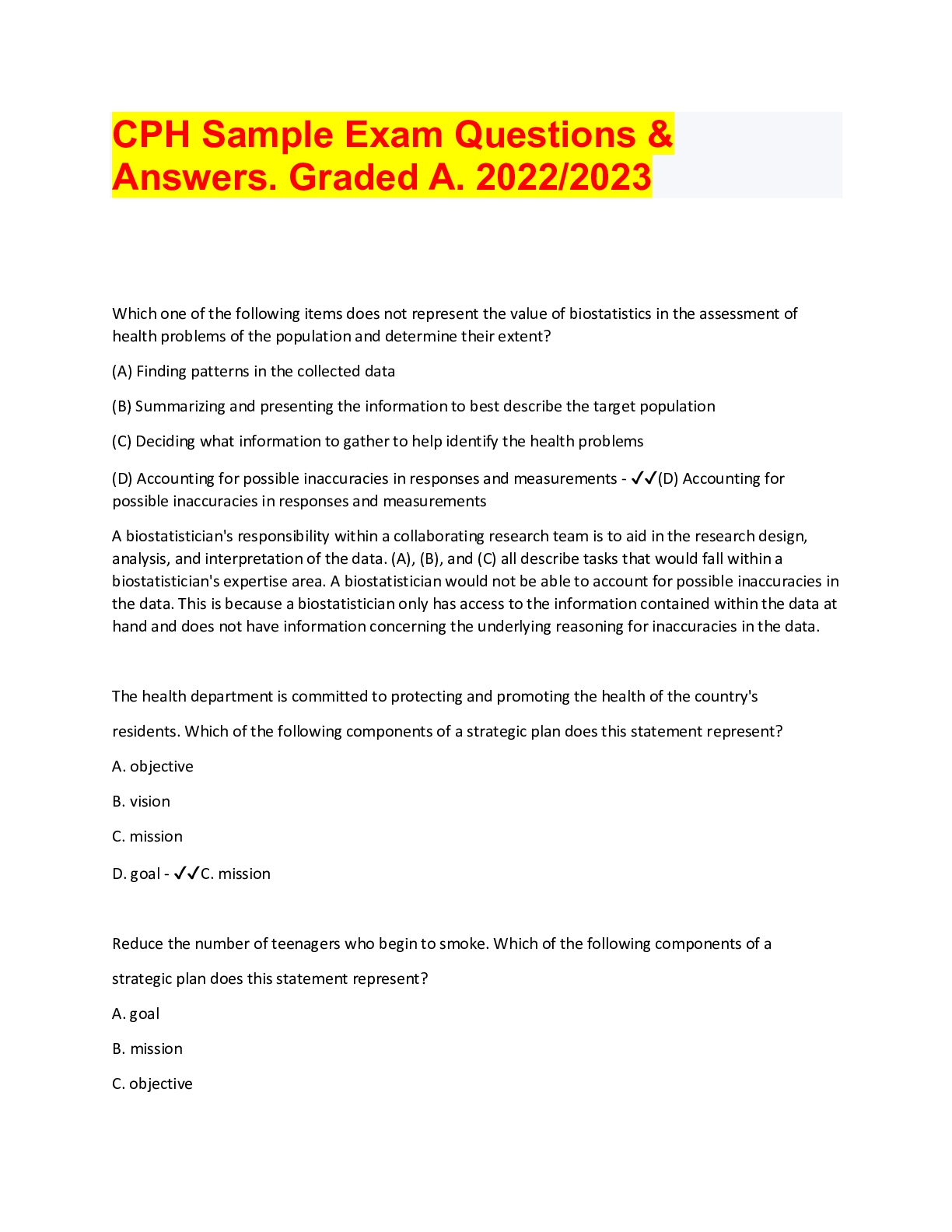
CPH Exams Bundle, 2022/2023 updates, Rated A
All CPH exam questions with accurate answers, All you need to pass the CPH EXAMS, FOR ENQUIRIES REACH ME AT wamaesymonatgmail
By bundleHub Solution guider 3 years ago
$20
5
Reviews( 0 )
$10.00
Can't find what you want? Try our AI powered Search
Document information
Connected school, study & course
About the document
Uploaded On
Sep 19, 2022
Number of pages
49
Written in
All
Seller

Reviews Received
Additional information
This document has been written for:
Uploaded
Sep 19, 2022
Downloads
0
Views
182













